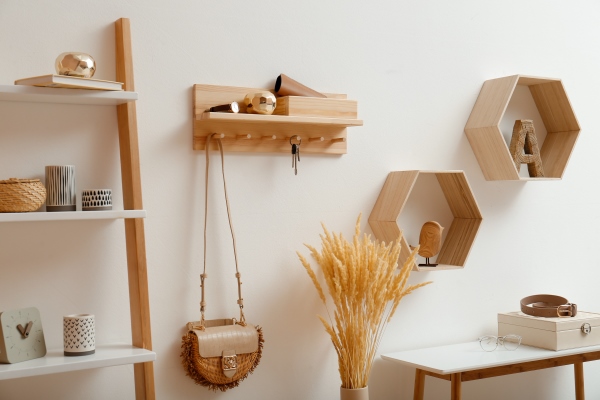Decluttering and organising your space is essential for creating a stress-free and productive environment. Clutter can weigh heavily on your mental health, making it difficult to focus and relax. Additionally, a disorganised space can lead to wasted time searching for misplaced items and increased anxiety levels. By decluttering and organising your space, you can improve your overall well-being and increase your productivity. In this article, we will provide you with ten practical tips to help you achieve a clutter-free and organised space. From starting with a plan to rotating seasonal items, we’ve got you covered.
Tip #1: Start with a Plan
Starting with a plan is crucial for successfully decluttering and organising your space. Begin by identifying areas of your home or workspace that need attention. Take note of any areas that feel cramped, disorganised, or overwhelming. Next, set specific goals for what you want to achieve. Do you want to free up space, reduce clutter, or improve functionality? Having clear objectives will help guide your process. Finally, create a timeline and schedule for completing tasks. Break larger tasks into smaller, manageable chunks, and allocate time slots for each task. This will help you stay on track and ensure that you make consistent progress.
Tip #2: Sort and Purge
Start by gathering boxes or bins labelled “keep,” “donate,” “sell,” and “recycle.” These categories will help you quickly identify where each item belongs. Then, go through each item in your space and sort it into its corresponding category. Be ruthless about getting rid of items you no longer need or use. Ask yourself if you have used the item in the past year, and if not, consider letting it go. It’s also helpful to consider the 80/20 rule – 80% of the time, you likely only use 20% of your belongings. Remember, the goal is to create a space that feels peaceful and functional, not one that’s bogged down by unnecessary clutter.
Tip #3: Use Storage Containers

Using storage containers is a great way to keep your belongings organised and easy to find. First, invest in storage containers that fit your space and needs. Consider the size, shape, and material of the containers, as well as the type of items you will be storing. Next, label each container so you know what’s inside without having to open it. This will save you time and energy when you need to find something quickly. Finally, store items in a way that keeps them visible and accessible. Consider stacking containers or placing them on shelves, and keep frequently used items at eye level.
Tip #4: Utilise Vertical Space
Utilising vertical space is a great way to maximise your space and keep it clutter-free. One way to do this is to make the most of walls by using shelves, hooks, and baskets. Shelves can be used to store books, decorative items, and other knick-knacks, while hooks can be used to hang coats, hats, and bags. Baskets can be hung on the wall or placed on shelves to store items like blankets, toys, and office supplies. Another option is to consider installing floating shelves or wall-mounted organisers. These can be used to store additional items and create more visual interest in a room.
Tip #5: Implement a “One Touch Rule”
Implementing a “one-touch rule” can help you stay organised and efficient by reducing the amount of time spent handling items multiple times. When you pick up an item, try to deal with it right away rather than putting it down and dealing with it later. If it’s something that can be put away quickly, such as a book or a kitchen gadget, do so immediately. If it requires action, such as paying a bill or responding to an email, add it to your to-do list or calendar so you won’t forget about it.
Tip #6: Designate Zones
Designating zones within your space can help you stay organised and focused by creating distinct areas for different activities. Identifying how you use your space and what activities you want to accomplish in each area. For example, you might create a “work zone” for productivity, a “relaxation zone” for downtime, a “play zone” for kids or pets, or a “storage zone” for items that don’t have a designated home. Once you’ve identified your zones, keep items related to each zone in their designated area. Defining zones can help you establish boundaries and routines, which can contribute to a more organised and peaceful living or work environment.
Tip #7: Maintain Clutter-Free Surfaces
Maintaining clutter-free surfaces is a key aspect of keeping your home or workspace organised and tidy. To achieve this, it’s important to keep surfaces like countertops, tables, and desks clear of clutter. This means removing any items that are not necessary for the immediate task at hand and finding a designated spot for everything else. Use trays, baskets, or small containers to corral items that tend to accumulate, such as keys, mail, or loose change. This will help prevent clutter from building up and make it easier to clean and maintain your space.
Tip #8: Practice Mindful Consumption
Before buying something new, take a moment to consider whether you truly need it. Ask yourself if you have a legitimate use for the item, or if it’s just something you want in the moment. This simple practice can help you avoid making impulse purchases and reduce the likelihood of buyer’s remorse. Additionally, choose quality over quantity when it comes to possessions. Instead of buying cheap, disposable items that may break easily or lose their usefulness quickly, opt for higher-quality items that will last longer and bring greater satisfaction. By adopting these mindful consumption habits, you can reduce clutter, save money, and live more sustainably.
Tip #9: Rotate Seasonal Items

Rotating seasonal items is a simple yet effective way to keep your home clutter-free and organised. Store seasonal items like decorations, clothes, and accessories in labelled containers to keep them organised and out of sight. As the seasons change, swap out items to avoid clutter build-up. For example, replace winter coats and boots with spring jackets and sandals. Consider donating or selling items that are no longer needed or used to prevent clutter from accumulating in the future. By rotating seasonal items, you can keep your home feeling fresh and updated without sacrificing space or functionality.
Tip #10: Review and Refresh Regularly
Schedule regular reviews of your space to check in on your organisation and decluttering efforts. Update your system as needed based on changes in your life or habits. For example, if you’ve recently started a new hobby, consider adding a dedicated storage space for your equipment. Celebrate your progress and continue working towards a clutter-free and organised space. Don’t be too hard on yourself if you encounter setbacks – simply acknowledge them and get back on track. By consistently reviewing and refreshing your system, you’ll be able to maintain a space that feels calm, organised, and tailored to your needs.
In summary, decluttering and organising your space can improve your mental and physical health, increase productivity, and create a sense of calm and control. By implementing the tips outlined in this article, you can start the new year off right and enjoy a more organised, stress-free living or work environment. So, take the first step today and start reaping the benefits of a clutter-free space.



